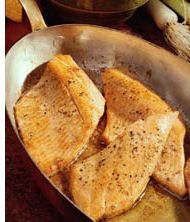No significant conversion of Hg species was observed with any of the common cooking treatments for fish. On the other hand, an overall loss of up to 33% of Hg species was observed after frying.
Background:
When discussing health risks from exposure to contaminants in food most often the data on the concentration of the contaminants is based on untreated foodstuffs. With respect to heavy metals, the question is whether the preparation of food in the kitchen has an influence on their concentration and speciation. Already in 2006 we reported about unpublished work of Gordon Brown from Stanford University under the title:
Methylmercury in fish: Can you cook it out ?
Brown had performed an experiment in which he investigated the influence of frying on the content of methyl mercury in tuna. The surprisingly result of this kitchen style experiment was that methylmercury content was not reduced but appeared to increase after drying. Whether this effect was obtained because of improved extraction efficiency du to the frying process was an open question.
Nine years after this preliminary experiment, now a group of researchers from Brazil and the UK picked up the topic and investigated the question in more detail. The researchers studied the effect of four cooking procedures (uncooked, boiling, frying and roasting) and also the influence of spicing (no spices, with salt, and with salt and lemon juice) on the content of mercury species in the cooked fish for 6 different fishes. Mercury speciation analysis was performed by HPLC-CVG-ICP-MS after extraction with L-cysteine and total mercury was determined after microwave digestion.
While no mercury loss could be oserved for boiling, roasting and frying resulted in some mercury loss. The highest Hg loss was found using the frying process on the bearded brotula sample, showing a total Hg loss of 33%, while for other fish species, the Hg loss ranged from 4 to 25%. No transformation of mercury species was observed and the loss of mercury was in the form of methylmercury. Since neither water nor the oil from the cooking process contained detectable amounts of Hg, it appears the volatilization of Hg is the main contributing process which can explain the loss of Hg in the processed fish.
 The cited study:
The cited study:
Lucas Schmidt, Cezar A. Bizzi, Fabio A. Duarte, Edson I. Muller,
Eva Krupp,
Jörg Feldmann, Erico M.M. Flores,
Evaluation of Hg species after culinary treatments of fish, Food Control 47 (2015) 413-419.
doi: 10.1016/j.foodcont.2014.07.040
 Related studies:
Related studies:
A.L. Maulvault, R. Machado, C. Afonso, H.M. Lourenço, M.L. Nunes, I. Coelho,
Bioaccessibility of Hg, Cd and As in cooked black scabbard fish and edible crab, Food and Chemical Toxicology, 49/11 (2011) 2808–2815.
doi: 10.1016/j.fct.2011.07.059

J.L. Domingo,
Influence of cooking processes on the concentrations of toxic metals and various organic environmental pollutants in food: a review of the published literature, Crit. Rev. Food Sci. Nutr., 51/1 (2010) 29-37.
doi: 10.1080/10408390903044511
L.A. Farias, D.I. Fávaro, J.O. Santos, M.B. Vasconsellos, A. Pessoa, J.P.L. Aguiar,
Cooking process evaluation on mercury content in fish, Acta Amazonica, 40 (2010) 741-748.
doi: 10.1590/S0044-59672010000400015
G. Perelló, R. Martí-Cid, J.M. Llobet, J.L. Domingo,
Effects of various cooking processes on the concentrations of arsenic, cadmium, mercury, and lead in foods, J. Agric. Food Chem., 56/23 (2008) 11262–11269.
doi: 10.1021/jf802411q 
J. Burger, C. Dixon, S. Boring, M. Gochfeld,
Effect of deep-frying fish on risk from mercury, J. Toxicol. Environ. Health, Part A, 66/9 (2003) 817-828.
doi: 10.1080/15287390306382
E.L. Chicourel, E. Sakuma, O. Zenebon,
Inefficacy of cooking methods on mercury reduction from shark, Arch. Latinoam. Nutr., 51/3 (2001) 288-292. freely available via
SCIELO
J.N. Morgan, M.R. Berry, R.L. Graves,
Effects of commonly used cooking practices on total mercury concentration in fish and their impact on exposure assessments, J. Expo. Anal. Environ. Epidemiol., 7/1 (1997) 119-33.
 Related EVISA Resources
Related EVISA Resources
 Link database: Toxicity of Organo-mercury compounds
Link database: Toxicity of Organo-mercury compounds  Link Database: Mercury exposure through the diet
Link Database: Mercury exposure through the diet  Brief summary: ICP-MS - A versatile detection system for speciation analysis
Brief summary: ICP-MS - A versatile detection system for speciation analysis Brief summary: LC-ICP-MS - The most often used hyphenated system for speciation analysis
Brief summary: LC-ICP-MS - The most often used hyphenated system for speciation analysis Related EVISA News
Related EVISA News

J
une 2, 2014: Methylmercury in fish: FDA updates its advice for consumers
 May 3, 2013: Standard methods for mercury speciation analysis
May 3, 2013: Standard methods for mercury speciation analysis June 8, 2006: Methylmercury in fish: Can you cook it out ?
June 8, 2006: Methylmercury in fish: Can you cook it out ?
 December 11, 2003: No degradation of TBT in seafood during cooking
December 11, 2003: No degradation of TBT in seafood during cooking
 April 27, 2004: New kind of mercury found in fish
April 27, 2004: New kind of mercury found in fish August 29, 2005: Is methyl mercury limiting the delight of
seafood ? - To answer this question is a challenge for elemental
speciation analysis
August 29, 2005: Is methyl mercury limiting the delight of
seafood ? - To answer this question is a challenge for elemental
speciation analysis February 9, 2006: Study show high levels of mercury in women related to fish consumption
February 9, 2006: Study show high levels of mercury in women related to fish consumption
last time modified: January 19, 2015